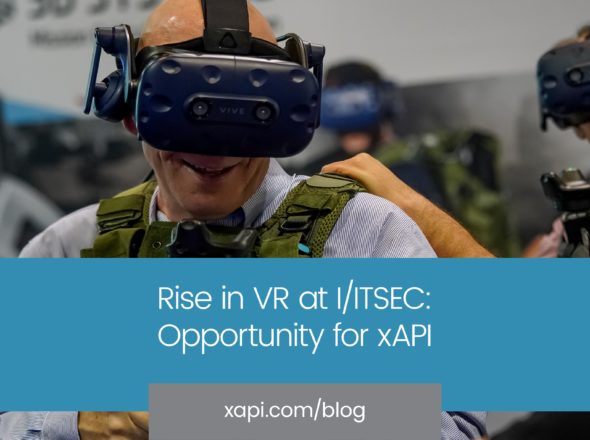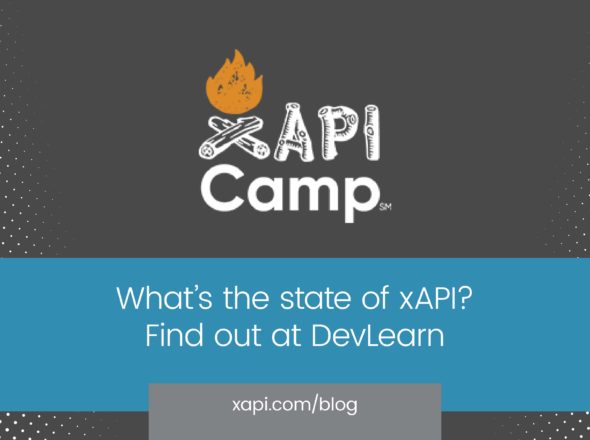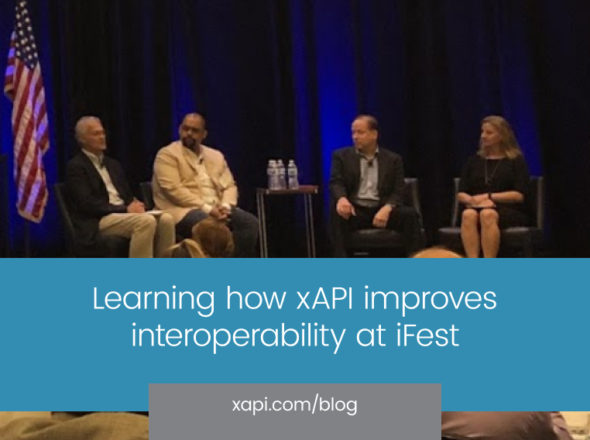Attendees of the 4/4/13 “xAPI in the Real World” webinar had a few questions that we couldn’t get to “on air”, so I’ve answered them here. There’s some good info in here, even if you couldn’t attend the webinar.
Q. Are there best practices for making information user-specific? When Mike was talking about QR codes, how does the individual’s user-specific data get added from a scanner application?
A. At this early point in xAPI’s life, I’m reticent to call anything a “best” practice yet. There are plenty of “plausible”, “demonstrated”, “functional” and “promising” practices, but it’s too early to know what is “best” yet.
In this particular use case, I would imagine that there is likely an app on the user’s phone that is preconfigured with the user’s identification. The app would likely have been authenticated against the LRS when it was installed, probably using OAuth.
Alternatively, a standard QR code reader could be used that brings up a web browser. When the user is first redirected to the web page providing the training or assessment, the user could be prompted to login with his/her network access credentials.
Q. Are there TCAPI plug ins for Yammer or Ning?
A. To the best of my knowledge, not yet. These would make great additions however and we’d love to see them. I believe the PulseWeb tool mentioned in the webinar can track Yammer posts, I don’t know the extent of the xAPI integration directly with Yammer however.
Q. Coming from a large organization with hundreds of courses, multiple LMS’s and a strong dependency on SCORM, what is a natural first step to begin incorporating xAPI?
A. I’d first want to know what you’re trying to accomplish by moving to xAPI. Are there specific pain points in your current program that you are trying to alleviate? Are there capabilities you would like to add that the current architecture does not facilitate?
We’re working with a lot of organizations in your shoes. We typically start by looking for pilot projects that alleviate pain or add a new capability. We find one or two things to demonstrate capability which have a lot of visibility and ROI. We’ve developed a methodology for identifying the business problems xAPI solves and the data we need to collect to show positive improvement.
Organizations often feel that they cannot begin adoption until their LMS vendor starts fully supporting xAPI. That is often not the case. Remember that xAPI facilitates migration of data between systems. That means it is easy to stand up an LRS to capture xAPI data now and then port it into your enterprise LMS when xAPI support arrives. Give us a call to talk about the possibilities some more, we are helping a lot of organizations get started right now, and whether you ultimately buy something from us or not, we enjoy the conversation.
Q. How is Open Badges by Mozilla compared to the Experience/Experience API…? Is this direct competition for users or will the two platforms work together…?
A. I see more possibility for collaboration than I do for competition. Experience API can be used in conjunction with Open Badges. You can have certain accomplishments that are recorded by xAPI, and let you earn badges. There is a demonstration of using xAPI statement as criteria for earning badges in our Watershed prototype. It doesn’t currently use Open Badges, but it would if it were not just a quick prototype.
Q. This is my first TinCan webinar. So, apologies if this has been answered before. Can we get to see demos (at least some) of these implementations to understand the functionalities better?
A. I’m sure any of these vendors would gladly demonstrate their capabilities for you. There are also a number of live prototypes you can play with at ../resources/.
Several of these are hooked into our Watershed prototype personal data locker. You can create an account for free, then interact with the bookmarklet and any of the sample activities and your statements will come back into your Watershed account.
Q. Have Blackboard and others started allowing outside apps to send over data so this data can be used by schools to evaluate data?
A. Blackboard has adopted xAPI at what we call the “SCORM parity” level so far. Outside apps can send data into the Blackboard LRS to create gradebook entries. Further adoption of xAPI functionality is still to come.
Q. I got the idea that a vendor can track the use of nearly any kind of material with xAPI (other than with SCORM). But: If we think of learning, especially in the context of informal learning, is something that “belongs” to the user – how does the user take “his” learning records with him from all the different vendors’ LRSses? Does the user need a LRS of his own if he wants to keep track of all his learnings? Or is this rather out of scope from the perspective of TinCan – you could argue the user might not even know he’s learning at the point where he is reviewing some material…
A. Lots of good questions and points here:
Yes, a vendor or learner can track nearly any kind of material with the Experience API. I would even say this includes SCORM content. Our SCORM Engine and Cloud will currently play SCORM content and then report the results as xAPI statements in an LRS. On the Vanderbilt Medical Center example from the presentation, that is the role of the Training Delivery System (TDS). The TDS is a centralized system for storing and delivering SCORM content that will report back to the LRS via xAPI.
We do believe that learning records should belong to the learner (with the possible exception of very confidential employer-delivered training). xAPI provides the technology to make these records very portable across LRSs. We don’t know how this will manifest itself from a business perspective just yet. Our vision is that there is a Personal Data Locker LRS that any learner can store his/her data in. The learner would be responsible for recording informal learning events into the PDL as desired. Our hope is that corporate or educational LRSs would then offer the capability to read from and write to the PDL. The learner would choose a subset of learning records that is public, or readable by select organizations. The corporate LRS would then import these records and make them part of the learner’s overall profile. Similarly, the corporate LRS would contribute a subset of relevant statements to the learner’s PDL.
Q. Is the use of Experience API royalty free?
A. Absolutely. The Experience API spec is a completely open specification that can be used by anybody. Creation of the spec itself is even following an open source model that anybody can participate in (more info).
Q. May want to relate concept of personal data locker to this ed.gov initiative: http://www.ed.gov/edblogs/technology/mydata/
A. Absolutely. The good thing about having ADL, a government agency, create the xAPI spec is that they have good contacts in other parts of the government. There is already a lot of dialog between ADL and the Department of Education. We hope to see this dialog continue and I’m excited about the possibilities for xAPI to positively impact education.
Q. What is storyline doing with the API?
A. Articulate Storyline has included xAPI as a content publishing option. Content published as xAPI will be able to utilize their iPad mobile player. My understanding is that the next version of Articulate Studio will likely include support for xAPI more broadly across products.
Q. We are more interested in functionality and how to apply xAPI to our own educational platform and website. Can you recommend which webinar we should attend in the future?
A. Our first webinar introduces the concepts and capabilities of xAPI. The second provides a technical overview of xAPI. Both are recorded and available at ../webinar. From there I would recommend digging into the rest of the tincanapi.com website. We try to publish all of our resources up there and link to other useful resources. If you have a request for a specific webinar in the future or for more information, please let us know. If you have more questions, please feel free to ask us, whether you’re buying something from us or not we’re always happy to answer your questions about SCORM or xAPI.
Q. What organization maintains the API and is that organization responsible for future enhancements to the API?
A. Rustici Software created the Experience API in 2010-2011 as part of a research grant (“Project xAPI”) from the Advanced Distributed Learning Initiative (ADL). ADL is a research lab within the US Department of Defense. ADL is the owner and steward of the Experience API (which they officially call the Experience API). ADL is shepherding the development of the Experience API through an open working group that anybody can freely participate in. After the specification is developed and mature, ADL plans to hand it over to an open standards group for ongoing sustainment.


